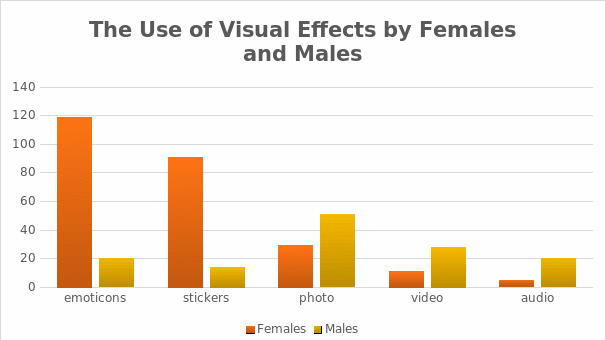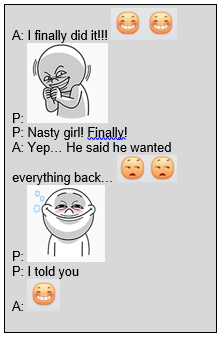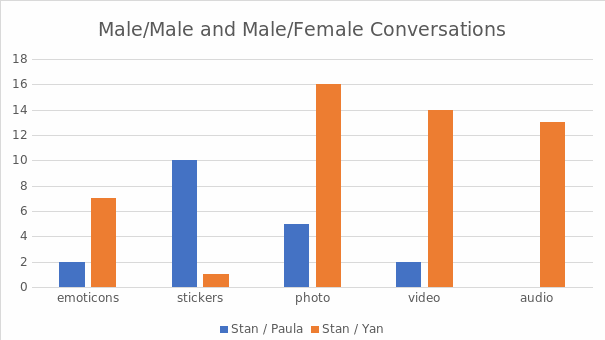Abstract
The present paper dwells upon the use of emoticons, stickers, photo, video and audio files in Line. The major focus of the research is gender differences. It is found that females are more emotional and use more emoticons and stickers while males tend to share more video, audio and photo files. The data also suggest that males often use emoticons and stickers when communicating with females. Further research may imply analysis of the influence of interpersonal relationships as well as features of character on the use of visual effects.
Introduction
People used to be worried about the role of phones in their lives lamenting about lost face-to-face communication. Development of technology has brought other issues to worry about but it also helped people add an emotional component to their media communication. Social media and instant messaging enable people to have emotional conversation and the effect is achieved through the use of emoticons, stickers, photo, video and audio files (Tardanico 2012). The sphere of digital communication is perfect for researching gender differences in communication patterns. This paper will focus on gender differences in the use of emoticons, photo, stickers, video and audio files in such instant messaging application as Line.
Literature Review
It is necessary to note that there is rather limited bulk of works on the use of emoticons in digital communication. Thus, researchers see emoticons as linguistic elements that enrich communication and adds nonverbal elements (Jibril & Abdullah 2013: 205). It is noteworthy that researchers are also interested in cross-cultural aspect of the use of emoticons. Park et al. (2013) note that people having similar cultural backgrounds tend to use similar emoticons and stickers. Azuma and Ebner (2008: 972) also support this view and they add that emoticons can soon become a “universal visual language” of the future.
Gender issues have also been a topic of researchers’ attention. Tossell et al. (2012) note that females use emoticons more extensive but males use more varied emoticons and stickers. Clearly, the use of emoticons, stickers, photo, and videos varies and this variety can be explained by diversity of people’s characters. Hence, it is possible to assume that these visual effects can be compared to nonverbal tools of communication.
Methodology
The focus of the Study
The paper focuses on gender differences in the use of emoticons, stickers, photo, video and audio files. Mixed research method will be used with a focus on qualitative data. The hypothesis of the present paper is as follows:
Females use more visual effects that are more varied while males do not use emoticons or stickers but may use video and audio files.
Participants and Procedure
Four people will take part in the research. The names are used for convenience (and they are changed). Stan is 29 married man. He is a manager. Yan (Stan’s friend) is a 28 married man. He is an IT specialist. Paula, Stan’s wife, is 27 and she is an administrator. Anna is 27 and she is Paula’s friend.
The present paper will include analysis of conversations in Line that took place during a month. Major attention is paid to the use of such visual effects as emoticons, stickers, photo, video and/or audio files. Major results will be provided in the form of graphs
Results and Discussion
It is necessary to note that the results of the research supported the hypothesis but there are some unexpected data (see Table. 1). It is necessary to note that relationship have a significant impact on the choice of visual effects.
Table 1 – The Use of Visual Effects by Participants.
First, it is necessary to note that males tend to use photo, video and audio files more than emoticons and stickers (see Fig. 1).

Females prefer expressing their attitude towards the utterance of their interlocutors. For instance, it is possible to consider a short extract of the conversation between Paula and Anna.

It is clear that females use the emoticons and stickers to reveal their attitude towards some events they are sharing. Even such a short extract shows that conversations are highly emotional in the majority of cases. The participants do not use many words but the conversation seems complete, as it is obvious that it is a result of some actions both females know about. At the same time, it is interesting that Paula tends to use stickers while Anna employs emoticons (see Table 1). It is necessary to note that females may often share conversations with other people (which makes the majority of photo files sent).
It is possible to consider a very short extract of a typical conversation between males. The extract is as follows:

The vast majority of conversation with the use of visual effects are very similar to the one provided below. Males seem to use visual effects just to share certain information. Usually these are funny things. Notably, they do not use emoticons to show they think the joke is funny. They may use punctuation marks. This may be explained by the fact that males are quite busy and do not think that their emotions are worth much of their attention.
Surprisingly, the things are different in conversations between a male and a female (See Fig. 2). Stan uses stickers when communicating with his wife Paula. It is necessary to add that these are often responses. However, they are often used to create an atmosphere of a game. It is also necessary to note that Paul shared quite a lot of photo and video files with his wife.

Conclusion
The research held focused on peculiarities of the use of such visual effects as emoticons, stickers, photo, video and audio files in Line. The major focus was made on gender differences. It turns out that women are more emotional in digital conversations and visual effects help them reveal their emotions. At the same time, males tend to share various files. At that, when communicating with a female, males tend to be more emotional and use stickers. This makes the conversation livelier. Clearly, the number of participants is limited and further research is necessary. It can be interesting to concentrate on the way interpersonal relationships affect the choice of visual effects. It can be also interesting to trace the role character plays on the use of stickers and emoticons as people (female participants) tend to use different tools.
References
Azuma, Junichi & Martin Ebner. 2008. A Stylistic Analysis of Graphic Emoticons: Can they be Candidates for a Universal Visual Language of the Future? Original printed in: Proceeding of World Conference on Educational Media, Hypermedia and Telecommunications (ED-Media), 972-977.
Jibril, Tanimu Ahmed & Mardziah Hayati Abdullah. 2013. Relevance of Emoticons in Computer-Mediated Communication Contexts: An Overview. Asian Social Science 9(4), 201-207.
Park, Jaram, Vladimir Barash, Clay Fink & Meeyoung Cha. 2013. Emoticon Style: Interpreting Differences in Emoticons Across Cultures. Proceedings of the Seventh International AAAI Conference on Weblogs and Social Media, 466-475.
Tardanico, Susan. 2012. Is Social Media Sabotaging Real Communication?Forbes. Web.
Tossell, Chad C., Philip Kortum, Clayton Shepard, Laura H. Barg-Walkow, Ahmad Rahmati & Lin Zhong. 2012. A Longitudinal Study of Emoticon Use in Text Messaging from Smartphones. Computers in Human Behavior 28(1), 659-663.